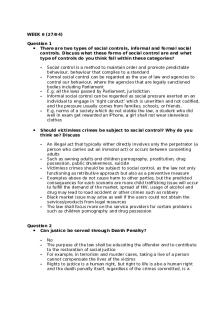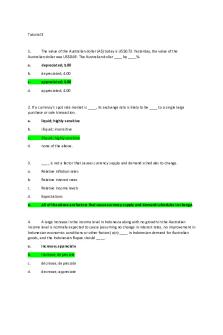chapter 3 tutorial pure substances PDF

| Title | chapter 3 tutorial pure substances |
|---|---|
| Author | NURUL AFIQAH BINTI A NURUL AFIQAH BINTI ABD HADI |
| Course | Thermodynamics |
| Institution | Universiti Teknologi MARA |
| Pages | 8 |
| File Size | 182.9 KB |
| File Type | |
| Total Downloads | 44 |
| Total Views | 157 |
Summary
tutorial chapter 3 pure substances, complete the table h2o...
Description
NURUL AFIQAH BT ABD HADI CEEH220
Pure Substances, Phase-Change Processes, Property Diagrams 3–3C What is the difference between saturated vapor and superheated vapor? o -A vapor that about to condense is called saturated vapour. A vapor that is not about to condense or otherwise is called superheated vapor. o The difference between saturated vapor and superheated vapor is that for saturated vapor, if we extract relatively small amount of heat from the vapor, it will start to condense. Whereas, for superheated vapor, the state will remain only vapor. 3–4C What is the difference between saturated liquid and compressed liquid? o Saturated liquid is a type of liquid in which no kind of solute can be added for that temperature. o Compressed liquid, on the other hand, is defined as the extra punch or extra pressure that is being given or applied in relation to a type of pressure called atmospheric pressure. 3–5C If the pressure of a substance is increased during a boiling process, will the temperature also increase or will it remain constant? Why? o The temperature will also increase since the boiling or saturation temperature of a pure substance depends on pressure. Because one cannot be varied while holding the other constant when one changes, so does the other one. o Also, boiling is not the Isotherm process (Process at which temperature remains constant). So, if the pressure of a substance is increased during a boiling process then temperature is also getting change. 3–6C Is it true that water boils at higher temperature at higher pressure? Explain. o Yes, the higher pressure causes water to boil at a higher temperature, therefore the bonds are harder to break because the atoms are experiencing resistance towards breaking free of the liquid and rising into gas
Property Tables 3–11C Does the amount of heat absorbed as 1 kg of saturated liquid water boils at 100°C have to be equal to the amount of heat released as 1 kg of saturated water vapor condenses at 100°C? o Yes, The energy absorbed and released are same and equal to the latent heat of water corresponding to saturation temperature of 100∘ C.
NURUL AFIQAH BT ABD HADI CEEH220
3–16C Which process requires more energy: completely vaporizing 1 kg of saturated liquid water at 1 atm pressure or completely vaporizing 1 kg of saturated liquid water at 8 atm pressure? o It takes more energy to completely vaporize 1 kg of saturated liquid water at 1 atm than at 8 atm because the vaporization enthalpy decreases as the pressure increases. o As latent heat require for vaporisation reduces with pressure. 3–20C A perfectly fitting pot and its lid often stick after cooking, and it becomes very difficult to open the lid when the pot cools down. Explain why this happens and what you would do to open the lid. o A perfectly fitting pot and its lid often stick after cooking as a result of the vacuum created inside as the temperature and thus corresponding saturation pressure inside the pan drop. When the pot cools down after use, its temperature decreases along with its saturation pressure and then a vacuum appears. That's why it is difficult to open. o as an easy way to open the lid is to reheat the food. when the temperature rises to boiling point, the pressure rises to atmospheric value and thus the lid will come right off.
3–21 Complete this table for H2O: T, oC 143.61
P, kPa 400
u, kJ/kg 1450
phase description saturated mixture
220
2319.6
2601.3
saturated vapor
190
2500
806
compressed liquid
466.24
4000
3040
superheated vapor
o From table A-5 Tsat=143.61∘ C As 604.22kJkg hg @ p = 500 kPa = 2770.8 kJ/kg, Hence, State 5 is superheated steam. From Table A-6, for superheated steam, For p5 = 800 kPa =0.8 MPa, h5 = 3162.2 kJ/kg, T5 = 350 °C, v5 = 0.35442 m3/kg.
3–27 Complete this table for refrigerant-134a: (table 11,12,13) T, 0C 20 -12 86.22 8
P,kPa 572.07 185.37 400 600
u, kJ/Kg 95 35.78 300 62.39
phase description saturated liquid vapor mixture unsaturated liquid superheated vapor subcooled (compressed) liquid
For refrigerant 134a: o T = 20 °C, u = 95 kJ/kg, From Table A 11, For T = 20 °C, psat = 572.07 kPa, uf = 78.86 kJ/kg, ug = 241.02 kJ/kg, vf = 0.0008161 m3/kg, vg = 0.035969 m3/kg, As uf < u < ug , Hence, State is saturated liquid vapor mixture, u−uf 95−78.86 x= vg−vf = 241.02−78.86=0.09953 as, x=
v−vf vg−vf v−0.0008161
0.0995= 0.035969−0.0008161 v=0.004315m3/kg o T = 12 °C, Saturated liquid, From Table A 11, For T = 12 °C, psat = 185.37 kPa, u = uf = 35.78 kJ/kg, v = vf = 0.0007499 m3/kg, x = 0 o p = 400 kPa , u = 300 kJ/kg, From Table A 12, Data for p = 400 kPa T−80
hence, 90−80 = T=86.22 0C
300−294.53 303.32−294.53
v−0.068747
300−294.53
so, 0.071023−0.068747 = 303.32−294.53 v=0.07016 m3/kg
NURUL AFIQAH BT ABD HADI CEEH220
From Table A-12, For p = 400 kPa, Tsat = 8.91 °C, Tsat = 185.37 kPa, vf=0.0007907 m3/kg& vg = 0.051201 m3/kg.
o p = 600 kPa, From Table A 12, For p = 600 kPa, Tsat = 21.55 °C. As T (= 8 °C) < Tsat at p = 600 kPa (=21.55 °C), hence state is sucbcooled (compressed) liquid. Hence, conditions are nearly the same as those at Saturated liquid corresponding to T = 8 °C. Hence, From Table A 11, corresponding to T = 8°C v = vf = 0.0007887 m3/kg & u = uf = 62.39 kJ/kg
3–28 A 1.8-m3 rigid tank contains steam at 220°C. One-third of the volume is in the liquid phase and the rest is in the vapor form. Determine (a) the pressure of the steam, (b) the quality of the saturated mixture, and (c) the density of the mixture. a) Properties; At 220°C vf= 0.001190 m3/kg and vg= 0.08609 m3/kg (Table A-4). Analysis(a) Two phases coexist in equilibrium, thus we have a saturated liquid-vapor mixture. The pressure of the steam is the saturation pressure at the given temperature. Then the pressure in the tank must be the saturation pressure at the specified temperature, P=Tsat at 220 °C= 2320kPa b) The total mass and the quality are determined as; 1/3 (1.8m3 mf=Vf/vf = 0.001190m3/kg=504.2 kg 2/3 (1.8m3)
mg=Vg/vg = 0.08609 m3/kg=13.94 kg mt=mf+mg=504.2+13.94=518.1 kg 13.94
mt=mg/mt = 518.1=0.0269 x=mg/mt=13.94/518.1=0.0269 c) The density is determined from; v=vf+x(vg-vf)=0.001190+(0.0269)(0.08609)=0.003474 m3/kg p=1/v=1/0.003473=287.8 kg/m3
NURUL AFIQAH BT ABD HADI CEEH220
3–30 A piston–cylinder device contains 0.85 kg of refrigerant- 134a at –10°C. The piston that is free to move has a mass of 12 kg and a diameter of 25 cm. The local atmospheric pressure is 88 kPa. Now, heat is transferred to refrigerant-134a until the temperature is 15°C. Determine (a) the final pressure, (b) the change in the volume of the cylinder, and (c) the change in the enthalpy of the refrigerant-134a. a. The final pressure is equal to the initial pressure, which is determined from *NEED TO SKETCH DIAGRAM (BOX) P2=P1=Patm+
mpg
D2/4 = 88 kPa + (12kg)(9.81m/s2)/(0.25m)2/4 x (1kN/1000kgm/s2) = 90.4 kPa
b. The specific volume and enthalpy of R-134a at the initial state of 90.4 kPa and -10°C and at the final state of 90.4 kPa and 15°C (interpolate) v1= 0.2302 m3/kg, h1= 247.76 kJ/kg v2= 0.2544 m3/k, h2= 268.16 kJ/kg The initial and the final volumes and the volume change are V1=mv1=(0.85 kg) (0.2302 m3/kg)= 0.1957 m3 V2=mv2= (0.85 kg)(0.2544m3/kg)=0.2163 m3 V=0.2162-0.1957=0.0205 m3 c. The total enthalpy change is determined from* tunjuk interpolation H=m(h2-h1)=(0.85kg)(268.16-247.76)kJ/kg=17.4 kJ/kg
3–31 10 kg of R-134a fill a 1.115-m3 rigid container at an initial temperature of – 30°C. The container is then heated until the pressure is 200 kPa. Determine the final temperature and the initial pressure. Answers: 14.2°C, 84.43 kPa V1=V2=v/m =1.115m3/10kg =0.115m3/kg P1=Psat-300C =84.43 kPa (refer table A-11) P2=200kPa
NURUL AFIQAH BT ABD HADI CEEH220
v2=0.115m3/kg hence, T=14.2 0C (refer table A-13)
3–34 What is the specific volume of R-134a at 20°C and 700 kPa? What is the internal energy at that state? *tsat>T = compressed liquid, refer table R-134a, 20 C, 700 kPa V=Vt at 20C = 0.0008169 m3/kg u=ut at 20 C= 78.85 kJ/kg 3–36 One kilogram of R-134a fills a 0.14-m3 weighted piston–cylinder device at a temperature of –26.4°C. The container is now heated until the temperature is 100°C. Determine the final volume of the R-134a. Answer: 0.3014 m *lukis box refer table A-12 at -26.37C, Vf=0.0007259 m3/kg, Vg=0.19254 m3/kg since the initial specific volume is 0.14 m3/kg, the initial state is in the saturated mixture region. the pressure in the wet region Is the saturated pressure at -26.4 C P1= P2=Psat at -26.4C= 100 kpa (refer table A-12) since we know final pressure and temperature, table A-13 yields a specific volume V2 that is grater than Vg. therefore, the state of refrigerant is superheated. P2=100 kPa,T=100C= v2=0.30138 m3/kg (refer table superheated) final volume, V2=mv2=(1kg)(0.30138m3/kg)=0.30138 m3...
Similar Free PDFs

Tutorial Chapter 3 FIN323
- 4 Pages

chapter 5 - Separation of Substances
- 11 Pages

Tutorial 3 Chapter 7 answers
- 6 Pages

Major Substances of Abuse
- 6 Pages

Pure obligations
- 6 Pages

Tutorial 3
- 3 Pages

Tutorial 3
- 4 Pages

Tutorial 3
- 4 Pages

Tutorial 3
- 12 Pages

3 - tutorial
- 6 Pages
Popular Institutions
- Tinajero National High School - Annex
- Politeknik Caltex Riau
- Yokohama City University
- SGT University
- University of Al-Qadisiyah
- Divine Word College of Vigan
- Techniek College Rotterdam
- Universidade de Santiago
- Universiti Teknologi MARA Cawangan Johor Kampus Pasir Gudang
- Poltekkes Kemenkes Yogyakarta
- Baguio City National High School
- Colegio san marcos
- preparatoria uno
- Centro de Bachillerato Tecnológico Industrial y de Servicios No. 107
- Dalian Maritime University
- Quang Trung Secondary School
- Colegio Tecnológico en Informática
- Corporación Regional de Educación Superior
- Grupo CEDVA
- Dar Al Uloom University
- Centro de Estudios Preuniversitarios de la Universidad Nacional de Ingeniería
- 上智大学
- Aakash International School, Nuna Majara
- San Felipe Neri Catholic School
- Kang Chiao International School - New Taipei City
- Misamis Occidental National High School
- Institución Educativa Escuela Normal Juan Ladrilleros
- Kolehiyo ng Pantukan
- Batanes State College
- Instituto Continental
- Sekolah Menengah Kejuruan Kesehatan Kaltara (Tarakan)
- Colegio de La Inmaculada Concepcion - Cebu





